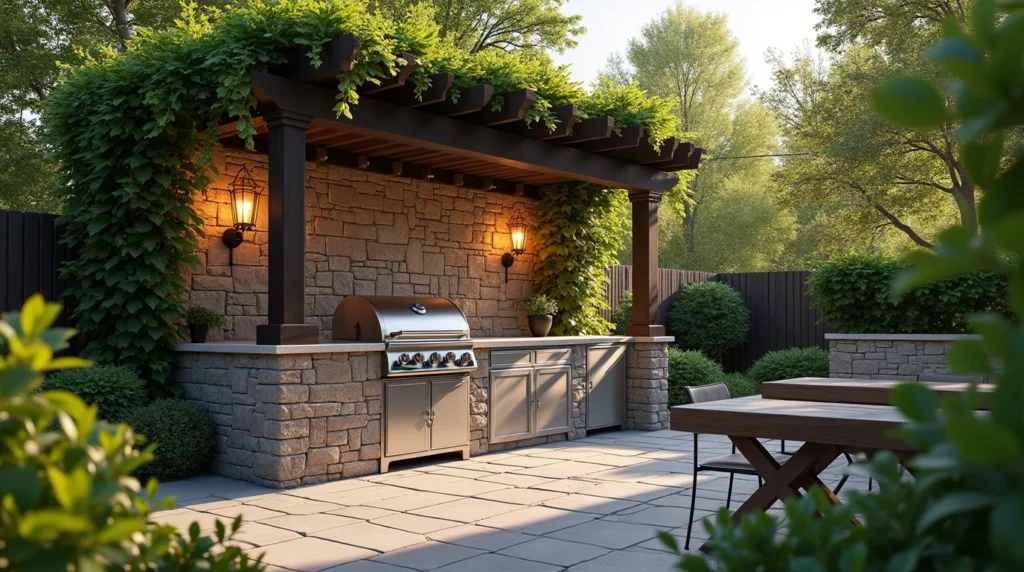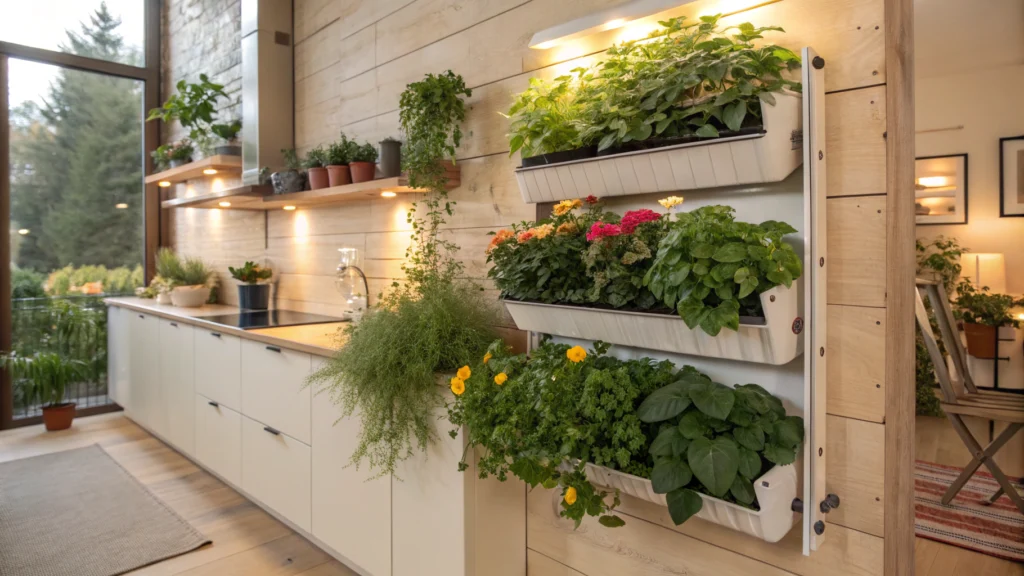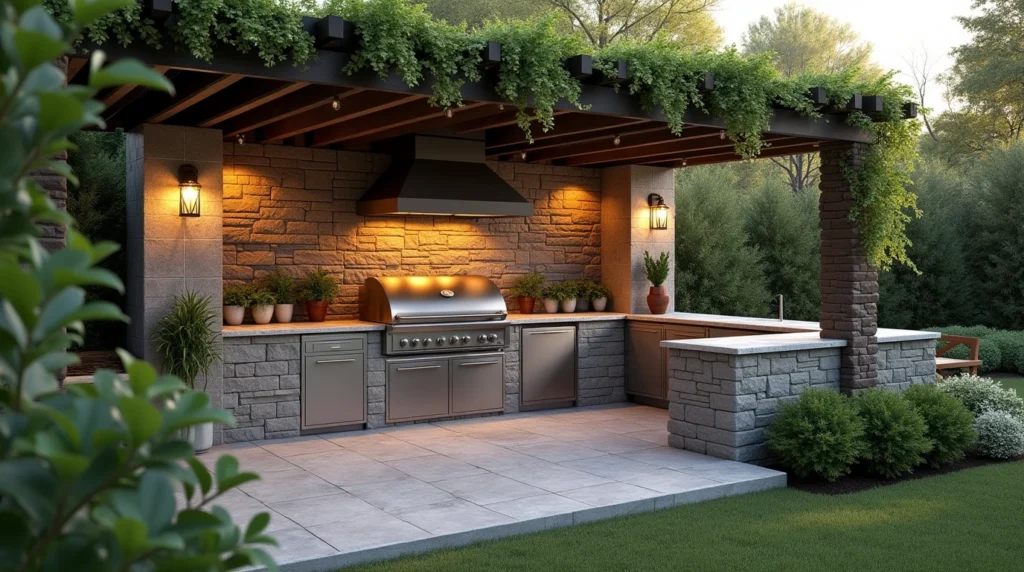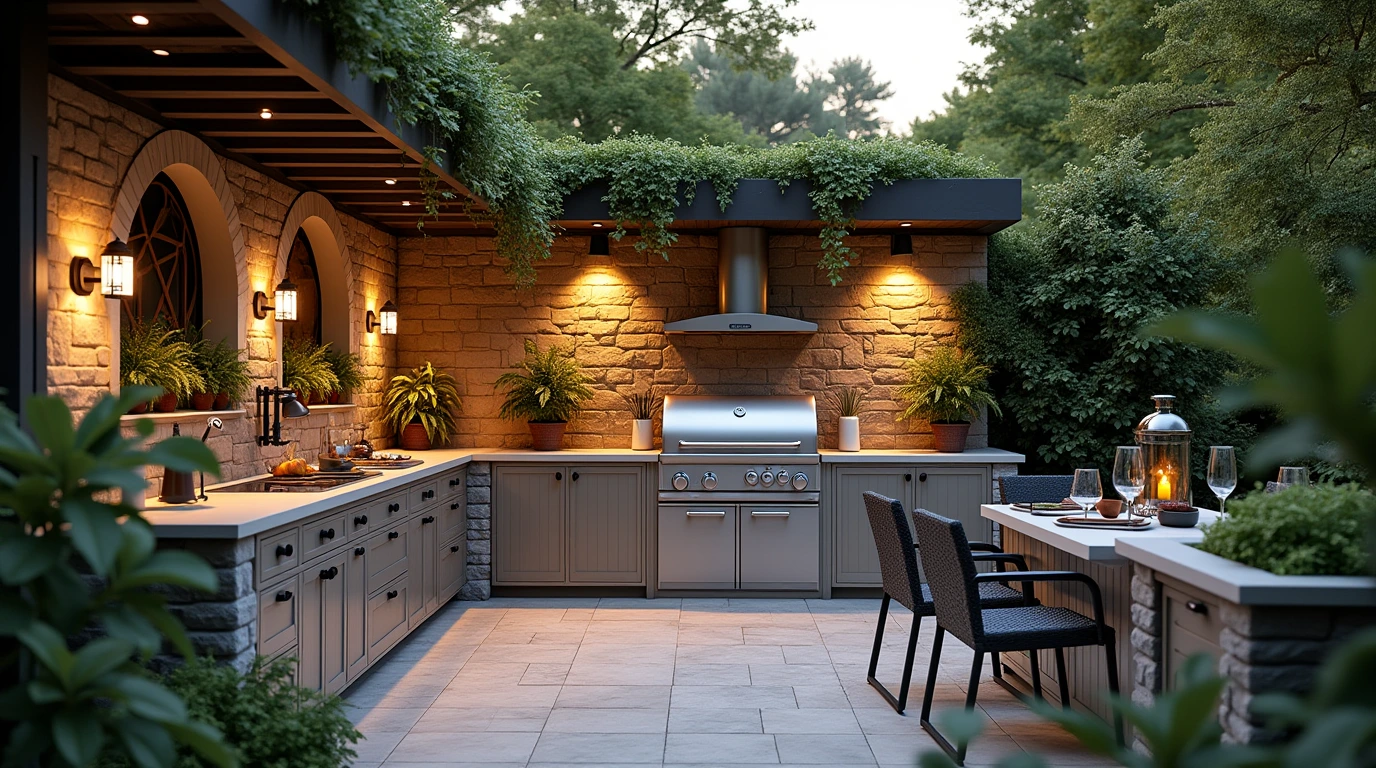Have you ever stood in your kitchen and felt something was missing? That spark of inspiration, that connection to nature that makes a house truly feel like home? Garden wall kitchens might be the transformative element your space has been craving. As the boundaries between indoor and outdoor living continue to blur, these innovative designs bring the freshness and vibrancy of nature directly into the heart of your home.
Imagine preparing dinner while surrounded by lush herbs, vibrant flowers, or even fresh vegetables—all within arm’s reach. Garden wall kitchens don’t just enhance your culinary experience; they revolutionize how you interact with your living space, bringing renewed energy and purpose to everyday cooking routines.
In this comprehensive guide, we’ll explore five stunning garden wall kitchen designs that can dramatically transform your space, regardless of its size or your gardening expertise. From space-saving vertical herb gardens to statement living walls, these concepts blend functionality with natural beauty to create kitchens that nourish both body and soul.
Table of Contents
What Exactly Are Garden Wall Kitchens?
Garden wall kitchens integrate living plants directly into kitchen design through vertical gardening systems. Unlike traditional kitchens with perhaps a potted herb on the windowsill, these designs make plants a central design feature through dedicated wall spaces that support growing vegetation.
The Core Elements of Garden Wall Kitchens
Garden wall kitchens combine several critical components:
- Living Plants: The heart of any garden wall kitchen, typically featuring herbs, small vegetables, ornamental plants, or a combination.
- Integration Systems: Structures including modular planters, hydroponic systems, or custom-built frames that affix to walls.
- Water Management: Solutions ranging from simple manual watering to sophisticated irrigation systems with drainage.
- Lighting: Natural or supplemental grow lights ensuring plants receive adequate illumination.
- Accessibility: Thoughtful placement allowing easy harvesting and maintenance while cooking.
Garden wall kitchens have gained tremendous popularity in recent years, especially in urban environments where outdoor space is limited. They represent the perfect marriage between biophilic design principles and functional food preparation spaces.
5 Transformative Garden Wall Kitchen Designs

1. The Herb Haven: Practical Culinary Garden Walls
The herb haven design focuses on maximizing culinary functionality by creating dedicated spaces for growing common cooking herbs. This approach is particularly ideal for passionate home cooks who appreciate having fresh ingredients within reach.
Key Features:
- Modular herb planter systems mounted near food prep areas
- Focus on culinary herbs like basil, thyme, mint, rosemary, and parsley
- Often integrates with existing cabinetry or unused wall space
- Typically requires minimal maintenance and water
Implementation Tips:
- Choose herbs based on your cooking preferences and frequency of use
- Group plants with similar watering and light requirements together
- Consider staggered planting to ensure continuous harvests
- Integrate small grow lights for winter months or in kitchens with limited natural light
Real-Life Example:
Sarah from Chicago transformed her small apartment kitchen with a simple wall-mounted herb garden using repurposed mason jars. “Having fresh basil and mint year-round has completely changed how I cook,” she notes. “Plus, the greenery makes my kitchen feel alive even during our harsh winters.”
| Herb Type | Light Requirements | Water Needs | Best Uses |
|---|---|---|---|
| Basil | Full sun/bright light | Moderate, consistent | Italian dishes, pesto, salads |
| Rosemary | Full sun | Low, allow to dry between watering | Roasts, potatoes, bread |
| Thyme | Full sun | Low, drought-tolerant | Soups, meat dishes, vegetables |
| Mint | Partial sun/shade | Moderate, consistent | Beverages, desserts, Mediterranean dishes |
| Parsley | Partial sun/shade | Moderate | Garnishes, salads, Middle Eastern cuisine |
2. The Living Pantry: Edible Garden Walls
Taking the concept of kitchen gardening to the next level, the living pantry design creates substantial growing space for vegetables and fruits within the kitchen environment. This approach emphasizes food production alongside aesthetic appeal.
Key Features:
- Larger dedicated wall systems capable of supporting vegetables and small fruits
- Often integrates hydroponic or aquaponic growing methods
- Requires more substantial infrastructure including water management systems
- Creates significant visual impact as a living feature wall
Best Plants for Living Pantry Walls:
- Leafy greens: lettuce, spinach, kale, arugula
- Cherry tomatoes and small peppers
- Strawberries and small fruits
- Quick-growing vegetables like radishes and microgreens
For maximum success with your living pantry, consider implementing a monitoring system for plant health. Many modern garden wall systems now include smart features that can alert you to watering needs or potential issues with your plants.
Implementation Considerations:
- Weight support – Ensure your wall can handle the additional weight of soil, plants, and water
- Water management – Install proper drainage systems to prevent moisture damage
- Lighting requirements – Most vegetables need significant light; plan for supplemental grow lights
- Accessibility – Design with harvesting in mind, keeping plants within reach
- Seasonal rotation – Plan for changing out plants based on growing seasons

3. The Biophilic Statement: Ornamental Living Walls
For those seeking dramatic visual impact alongside the psychological benefits of bringing nature indoors, ornamental living walls transform kitchen spaces with lush vertical gardens focused primarily on aesthetics rather than edibility.
Key Features:
- Dense plantings creating a “living art” effect
- Focus on foliage plants with various textures and colors
- Often covers larger wall sections as a dramatic design element
- May incorporate flowering species for seasonal color
- Usually requires professional installation and maintenance systems
Popular Plant Selections for Ornamental Walls:
- Pothos and philodendrons for trailing effects
- Ferns for textural interest
- Bromeliads for architectural structure
- Peperomia varieties for compact growth
- Peace lilies for air purification and occasional blooms
Benefits Beyond Beauty:
- Improved indoor air quality through natural filtration
- Enhanced acoustic properties reducing kitchen noise
- Psychological benefits including stress reduction and improved mood
- Potential temperature moderation effects
“Our kitchen living wall completely transformed not just how our space looks, but how it feels. The room seems to breathe now, and cooking has become a multi-sensory experience with the fragrance and visual texture of the plants surrounding us.” — Michael L., Garden Wall Kitchen owner
4. The Space-Saver: Vertical Gardens for Small Kitchens
You don’t need a sprawling kitchen to incorporate garden walls. The space-saver approach specifically addresses the challenges of bringing plants into compact kitchens through innovative vertical solutions that maximize growing area while minimizing footprint.
Key Features:
- Slim-profile growing systems that utilize vertical space efficiently
- Often incorporates multifunctional elements like herb growing with storage
- May use corner spaces or narrow wall sections typically underutilized
- Emphasizes lightweight systems with minimal water requirements
Smart Space-Saving Solutions:
- Wall Grid Systems: Wire or trellis grids supporting small hanging planters
- Over-Window Installations: Utilizing the often-unused space above windows
- Magnetic or Suction Systems: For renters who can’t permanently modify walls
- Cabinet-End Planters: Using end panels of cabinet runs for narrow herb gardens
- Under-Cabinet Growing: Systems with integrated grow lights beneath cabinets
Real-World Application:
In a 400 square foot apartment, Jordan created a thriving vertical herb garden by repurposing a shoe organizer with plastic pockets. Mounted on the only available kitchen wall, it provides fresh herbs year-round without sacrificing precious counter space.
5. The Hydroponic High-Tech: Modern Soilless Garden Walls
For tech enthusiasts and those seeking clean, efficient growing solutions, hydroponic garden wall systems offer cutting-edge approaches to indoor gardening with minimal mess and maximum efficiency.
Key Features:
- Soilless growing systems using nutrient-rich water solutions
- Often includes automated features for lighting and feeding
- Typically produces faster growth rates than traditional soil gardening
- Clean, contemporary aesthetic that complements modern kitchen design
- Reduced pest issues compared to soil-based systems
Popular Hydroponic Systems for Kitchen Walls:
| System Type | Space Required | Maintenance Level | Best For |
|---|---|---|---|
| NFT (Nutrient Film Technique) | Medium | Moderate | Leafy greens, herbs |
| Deep Water Culture | Medium-Large | Low | Larger vegetables, herbs |
| Ebb and Flow | Variable | Moderate | Versatile, multiple plant types |
| Wick Systems | Small | Very Low | Herbs, small plants |
| Aeroponics | Medium | High | Fast-growing herbs, specialty crops |
Smart Integration:
Many modern hydroponic systems connect to smartphone apps for monitoring plant health, nutrient levels, and automated feeding schedules. Some even integrate with smart home systems, allowing you to control growing conditions alongside other home automation features.
Planning Your Garden Wall Kitchen: Practical Considerations

Before diving into installing your garden wall kitchen, careful planning ensures success and prevents costly mistakes. Consider these critical factors:
Structural Requirements
- Wall Support: Ensure walls can support the additional weight of your chosen system
- Water Protection: Install proper waterproofing to protect walls from moisture damage
- Access to Utilities: Consider proximity to water sources and electrical outlets
- Temperature Factors: Assess proximity to heat sources like ovens that might affect plants
Lighting Solutions
Adequate light is crucial for plant growth, especially in indoor environments:
- Natural Light Assessment: Evaluate existing window exposure and duration of daily light
- Supplemental Lighting: Consider full-spectrum grow lights for areas with insufficient natural light
- Timer Integration: Automate lighting cycles to ensure consistent exposure
- Energy Efficiency: Look for LED solutions that provide appropriate spectrum without excessive energy use
Water Management Systems
Proper irrigation prevents both plant failure and water damage:
- Manual vs. Automated: Choose between hand-watering or installed irrigation based on lifestyle
- Drainage Solutions: Ensure excess water has somewhere to go
- Water Quality: Consider filtration for tap water with high mineral content
- Water Conservation: Look for systems that recirculate water when possible
Plant Selection Strategy
Choose plants that will thrive in your specific kitchen environment:
- Light Availability: Match plant needs to available light conditions
- Temperature Tolerance: Consider ambient kitchen temperatures including fluctuations from cooking
- Usage Frequency: For edible walls, plant what you’ll actually use in your cooking
- Growth Habits: Consider mature size and growth patterns to prevent overcrowding
- Companion Planting: Group plants that benefit each other and have similar care requirements
Maintenance and Care for Thriving Garden Wall Kitchens
Even the most beautifully designed garden wall kitchen requires ongoing maintenance to remain vibrant and productive. Establish these care routines for optimal results:
Daily Care Routine
- Visual inspection for signs of stress or pest issues
- Check moisture levels in growing medium
- Harvest mature herbs or vegetables as needed
Weekly Maintenance Tasks
- Thorough watering (if not automated)
- Pruning to encourage bushy growth
- Rotation of plants if light exposure is uneven
- Cleaning any water collection trays
Monthly Attention
- Fertilize according to plant needs
- Check and clean any irrigation components
- Assess overall plant health and replace struggling specimens
- Deep clean surrounding surfaces to prevent mold or mildew
Seasonal Considerations
- Rotate crops seasonally for edible walls
- Adjust lighting duration for seasonal changes
- Modify watering frequency based on seasonal humidity
- Consider supplemental humidity in dry winter months
Pro Tip: Create a maintenance calendar specific to your garden wall kitchen to keep track of feeding schedules, replanting times, and seasonal adjustments. Many plant care apps can help you maintain the perfect schedule for your specific plants.
Cost Considerations and ROI for Garden Wall Kitchens
Garden wall kitchens range dramatically in price depending on scale, complexity, and whether you choose DIY or professional installation. Understanding the investment and potential returns helps in planning appropriately.
Investment Ranges
Budget-Friendly Options ($100-$500):
- DIY vertical planters using repurposed materials
- Simple wall-mounted pot systems
- Basic modular herb gardens
- Small prefabricated vertical garden kits
Mid-Range Investments ($500-$2,000):
- Larger manufactured living wall systems
- Small hydroponic setups with basic automation
- Custom built-in herb garden installations
- Professional design consultation with DIY installation
High-End Installations ($2,000+):
- Fully integrated professional living walls
- Complete hydroponic systems with automation
- Custom designed and installed statement walls
- Comprehensive irrigation and lighting systems
Return on Investment
Beyond the immediate pleasure of growing your own plants, garden wall kitchens can provide tangible returns:
- Reduced Grocery Expenses: Fresh herbs and vegetables available without purchase
- Increased Property Value: Unique design features that appeal to future buyers
- Energy Efficiency: Potential insulation effects reducing heating/cooling costs
- Health Benefits: Improved air quality and access to nutritious fresh produce
- Psychological Value: Stress reduction and improved wellbeing from connection to nature
Common Challenges and Solutions for Garden Wall Kitchens

Even well-planned garden wall kitchens can face challenges. Here are solutions to common issues:
Challenge: Insufficient Light
Solutions:
- Install full-spectrum grow lights
- Choose shade-tolerant plant varieties
- Use reflective surfaces to maximize existing light
- Rotate plants between stronger and weaker light positions
Challenge: Pest Infestations
Solutions:
- Introduce beneficial insects like ladybugs
- Use neem oil or insecticidal soap for treatment
- Isolate affected plants immediately
- Maintain good air circulation to prevent fungal issues
Challenge: Inconsistent Watering
Solutions:
- Install automated irrigation with moisture sensors
- Use self-watering planters with reservoirs
- Group plants with similar water requirements
- Implement wicking systems for passive watering
Challenge: Limited Success with Certain Plants
Solutions:
- Research microclimate requirements more thoroughly
- Test soil or water pH and adjust accordingly
- Consider seasonal rotation rather than forcing unsuitable conditions
- Consult with local garden centers for region-specific advice
Conclusion: Embracing the Garden Wall Kitchen Revolution
Garden wall kitchens represent far more than just a design trend—they embody a fundamental shift in how we view our living spaces. By integrating natural elements directly into the heart of the home, these innovative installations reconnect us with nature’s cycles and the origins of our food.
Whether you’re drawn to the practical benefits of having fresh herbs at your fingertips, the aesthetic impact of a lush living wall, or the technological fascination of hydroponic systems, garden wall kitchens offer transformation on multiple levels. They enhance not just the appearance of your kitchen but also its functionality, atmosphere, and connection to sustainable living practices.
As you consider implementing one of these five transformative designs, remember that your garden wall kitchen can evolve with you. Start small if you’re unsure, perhaps with a simple herb collection, and allow your confidence and interests to guide potential expansions. The beauty of these systems lies in their adaptability—they can be as simple or sophisticated as suits your lifestyle and space.
Your kitchen walls hold untapped potential. With thoughtful planning and the right approach, they can become vibrant, living elements that transform your everyday cooking experience into something extraordinary—blending the boundaries between gardening and gastronomy in the most delightful ways.
FAQ: Garden Wall Kitchens
How much maintenance do garden wall kitchens require?
The maintenance level varies based on the system type and plants selected. Simple herb gardens might need just 5-10 minutes of attention weekly, while complex living walls or hydroponic systems could require 30 minutes to an hour per week. Garden wall kitchens generally require regular watering, occasional pruning, periodic fertilizing, and seasonal replanting for optimal results.
Can garden wall kitchens work in kitchens with limited natural light?
Absolutely! Garden wall kitchens can thrive in low-light kitchens with the addition of appropriate grow lights. LED grow lights specifically designed for plants provide the necessary spectrum for photosynthesis without excessive energy use. For kitchens with minimal natural light, select shade-tolerant plant varieties and implement lighting solutions that mimic natural growing conditions.
Will a garden wall kitchen cause moisture damage to my walls?
When properly designed and installed, garden wall kitchens should not damage your walls. Key prevention measures include waterproof backing materials, proper drainage systems, moisture barriers between the system and wall, and regular maintenance to check for any leaks or issues. Professional installation is recommended for larger systems to ensure appropriate waterproofing.
What are the best plants to start with for a beginner’s garden wall kitchen?
For beginners, hardy herbs like rosemary, thyme, and mint offer forgiving options that tolerate varied conditions. Other good starter plants include pothos, spider plants, and succulents for ornamental walls, or leaf lettuce and spinach for edible walls. Choose plants that match your light conditions and start with a smaller number until you develop confidence in your maintenance routine.
How can garden wall kitchens enhance the value of my home?
Garden wall kitchens can increase home value by adding distinctive design elements that appeal to buyers seeking sustainable, biophilic living spaces. They represent a unique selling point that distinguishes your property in the market. Additionally, integrated systems that are well-designed and properly maintained demonstrate thoughtful home improvement that enhances both functionality and aesthetics—key factors in property valuation.

